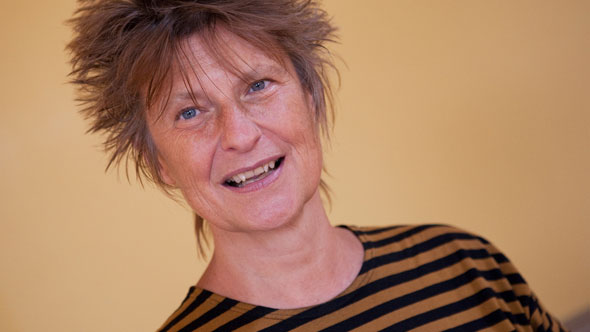Monica Voss, who lives and teaches in Toronto, recently conducted a weekend workshop at White Iris Yoga in Evanston. Three principles sum up the essence of Monica’s hatha yoga philosophy: 1) ground yourself, 2) breathe deeply, and 3) lengthen your spine. The rest of the posture will fall into place. However, most of us don’t know how to feel our spines. We can’t see them. They have become “anonymous”, and we need to bring them back to life, says Monica.
A workshop with Monica begins with a long, deep relaxation so students can experience an awareness of their spines and let go of tension before they even think about lengthening. By relaxing fully, we release the tensions that prevent us from feeling, moving and breathing. Through breathing deeply, feeling the support of the ground, and lengthening our spine, we renew or recreate ourselves, and inspiration arises from this “new spine, new breath, new thought”. And when practiced correctly, we experience a tremendous charge of energy, or a creative boost. “We clearly are in a new body,” says Monica.
Monica’s style of yoga is inspired by Vanda Scaravelli, a well know European teacher who studied privately for several summers with B.K.S. Iyengar and T.K.V. Desikachar when she was in her 50s. Vanda took the information she learned and developed a style that made hatha yoga easier, without straining. She found that by inhaling and exhaling deeply, she felt an energy and strength that moved like a wave. Her body followed, becoming supple and elastic, moving on this wave of energy without effort. Vanda, now 90, until just recently continued to teach and practice vigorous back bends and reverse postures (see Yoga Journal article May-June, 1996).
Monica, a former Iyengar style yoga teacher, studied with Vanda for ten years and changed her approach to yoga, adopting Vanda’s philosophy of practicing yoga effortlessly. “If you find yourself straining,” says Monica, “you are making a mistake.” Rather, she recommends developing and “inner connection” and first becoming comfortable.
“Keep checking from the feeling level, and pay attention to what your spine is doing. See what you feel,” says Monica. “It is an important clue as to whether it is right for you.”
But the practice is far more than simply lying around and doing what feels good. To increase awareness about how the spine moves, much time is spent practicing the cat pose, alternating from dog tilt (tailbone tilted back) to cat tilt (tail bone tucked under). The cat pose is practiced from many positions: sitting on the floor, kneeling, from a lunge position, and standing. Deep breathing is emphasized, and Monica suggests the spine is lengthened and supported by the breath.
In any pose, whether the students are standing, sitting, kneeling, or lying down, they are aware at all times of the spine, the breath, and the grounding. They soon realize that when any one of these elements in missing, the pose no longer becomes effortless, but is strained and difficult.
For instance, in backward bending poses such as the bridge, when the awareness of groundedness is missing, the back works harder. However, when the feet are pressing consciously into the floor, the back automatically lifts. (Try it!) Said one student in the workshop, “When you find where you are grounded, you lift out of that place rather than trying to hold yourself up straight.”
Gravity is already pulling the body down. So by consciously pressing the feet into the floor, the spine lifts, and the student experiences continuous movement from within without tension. Action within the body does not mean tension, Monica points out. But by grounding, breathing, and lengthening, the body moves into the poses with energy and ease.
YOGAChicago November – December 1998
with Monica Voss
By Sharon Steffensen
Monica and Esther Myers, also a student of Vanda Scaravelli and author of Yoga and You, conduct workshops from their Toronto studio and elsewhere.

